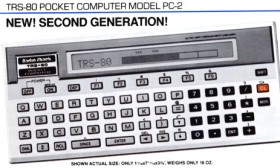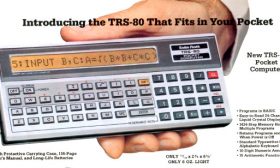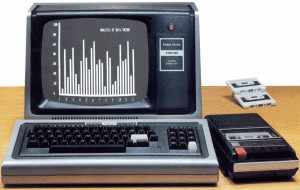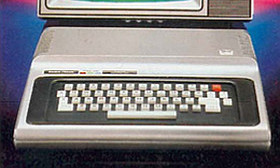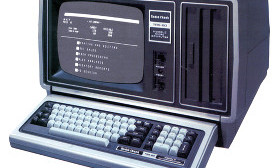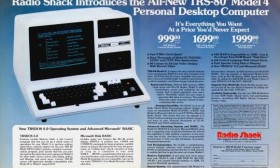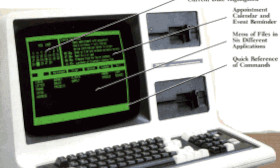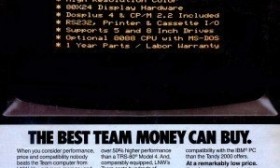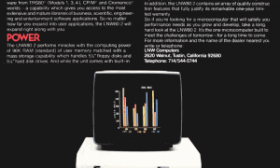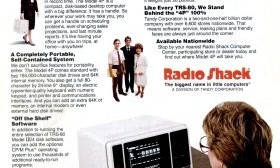Articles in the "Computers" Category
The TRS-80 Pocket Computer 2 (catalog number 26-3601), better known as the PC-2 (and even the Pocket Computer II in some early articles), was the most powerful member of Radio Shack’s family of Pocket Computers. The PC-2 wasn’t a replacement for the original Pocket Computer (known as the PC-1), but served as a more advanced (and more expensive) alternative.
The PC-2 cost $279.95 when it was introduced in 1982, but that price dropped to $199.95 by the following year. It was the only Pocket Computer that had speed and memory capacity that was competitive with a contemporary desktop computer. The PC-2 wasn’t manufactured by Radio Shack, but was a rebadged Sharp PC-1500. It wasn’t compatible with any of the hardware or software Radio Shack sold for the PC-1.
The PC-2 was larger and heavier than the PC-1. It measured 7 11/16" by 3 1/8" by 1 1/16", nearly one inch bigger in each dimension than the PC-1. It weighed 16 ounces (with batteries) compared to the six ounces of a PC-1.
(Read more...)
The TRS-80 Pocket Computer (catalog number 26-3501) was the first in Radio Shack’s line of pocket computers. It cost $249.00 when it was introduced on July 31, 1980, the same day as the TRS-80 Model III and the TRS-80 Color Computer. The Pocket Computer was renamed the PC-1 in 1982 after the PC-2 was introduced.
Unlike their other computers (the Model I, Model II, Model III, and Color Computer), the Pocket Computer wasn’t a Radio Shack design. It was actually a rebadged Sharp PC-1211, which had been introduced in Japan the same year. (At the time, the PC-1211 wasn’t available in the United States.)
(Read more...)
The Radio Shack TRS-80 Microcomputing System (catalog number 26-1001), later known as the TRS-80 Model I, was introduced by Radio Shack on August 3, 1977. It made computer history as one of the first mass marketed, fully assembled microcomputers. The initial price was $599.95, which included a typewriter-style (not membrane) keyboard, monitor, and cassette recorder.
The TRS-80 (which became known as the Model I after the Model II was introduced in 1979) was created by Don French and Steve Leininger. It ran a Zilog Z80 at 1.77 MHz and came with 4K of RAM, and a 4K ROM of what was called Level I BASIC. Only uppercase characters could be displayed, and the only means of storage was a cassette recorder. Despite these limitations, the TRS-80 was enormously successful. The initial production run sold out in less than a month, and it took almost a year for Radio Shack to catch up with the demand. Radio Shack sold 100,000 TRS‑80 computers in 1978, over four times its nearest competitor.
(Read more...)
The TRS-80 Color Computer, commonly nicknamed the CoCo, was the first in Radio Shack’s line of inexpensive home computers. Introduced on July 31, 1980 (the same day as the TRS-80 Model III and the TRS-80 Pocket Computer), the Color Computer was also known as the Colour Computer outside of the United States, and later as the Color Computer 1.
The Color Computer was part of Radio Shack’s attempt to diversify their computer product line. Costing only $399.00 for its basic model, it was designed to compete with other lower-cost computers, such as the Atari 400 and the Commodore VIC-20. But the Color Computer inspired a wide range of uses, multiple support magazines, and a vibrant third-party software and hardware market. The Color Computer series was probably the best selling of Radio Shack’s own computer models.
(Read more...)
The TRS-80 Model II was the first in the line of Radio Shack business computers that eventually included the Model 16, Model 12, and Tandy 6000. It was introduced at the June 1979 National Computer Conference in New York City. Radio Shack began taking orders that month for delivery in October, shipping 1,000 Model II’s by the end of year.
The introductory price for the Model II was $3450.00 for the 32K version (catalog number 26-4001) and $3899.00 for the 64K version (catalog number 26-4002). A 32K system could be later upgraded to 64K by purchasing the 32K add-on (catalog number 26-4102) for $449.00.
The Model II was actually the second business computer that Radio Shack sold. The previous year, Radio Shack offered the Tandy 10, a relabeled ADDS System 50. The Model II cost less than half the price of the Tandy 10, yet was far more powerful.
(Read more...)
The TRS-80 Model 4, introduced on April 26, 1983, was the continuation of the TRS-80 computer line that had begun with the Model I in 1977. The Model 4 was officially launched for the press on April 27 at an event sponsored by the Boston Computer Society.
The Model 4 was 100% compatible with the Model III and was able to run all Model III operating systems and applications. The designers of the Model 4 had taken great pains to ensure this complete compatibility to avoid the same kind of problems encountered when the TRS-80 Model III was introduced. The Model III had been only partially compatible with Model I software and lack of compatibility was viewed as a costly misstep by Radio Shack. Don White, the Model 4 product line manager, stated, “I took it once on the Model I/III incompatibility and I won’t go through that again.”
The Model 4 originally was available in three configurations:
(Read more...)
The TRS-80 Model 4D (catalog number 26-1070) was Radio Shack’s final entry in the line of TRS-80 computers that began in 1977 with the Model I. Many people (myself included) consider it to be the best TRS-80 and one of the finest 8-bit computers ever produced.
Introduced in late 1985 at a price of $1199.00, the Model 4D was completely compatible with the Model 4 that it replaced and the wide range of Model 4 and Model III hardware and software. Unlike previous TRS-80 computers, the Model 4D was branded by Tandy (the parent company of Radio Shack) rather than Radio Shack itself. The full name was the “Tandy TRS-80 Model 4D Microcomputer System.” Also unlike previous models, there was no cassette version of the Model 4D and it doesn’t appear that it was ever sold outside of the United States and Canada.
The Model 4D differed from the original Model 4 in several areas:
(Read more...)
The LNW Team was an intriguing idea for a computer to bridge the TRS-80 and MS-DOS worlds. It was sold by LNW Computers, the company responsible for the LNW System Expansion, the LNW80, and the LNW80 Model 2.
The computer appears to have been the same externally as the LNW80 Model 2, although the standard memory was increased to 160K and the clock speed increased to 5.3 MHz. What really set the LNW Team apart was the optional 8088 board.
(Read more...)
The LNW80 Model 2, sometimes referred to as the LNW80/2, was a TRS-80 compatible computer sold by LNW Computers (formerly LNW Research Corporation). Introduced in late 1982 for a price of $2695, the LNW80 Model 2 was an upgrade to the original LNW80. The LNW80 Model 2 provided nearly complete compatibility with the TRS-80 Model I but added many new features and enhancements. In addition to being available through direct sales or through dealers in the United States, the LNW80 Model 2 was also sold in Australia and New Zealand through Micro-80 magazine.
Unlike the earlier LNW80, the LNW80 Model 2 was only sold as a complete computer, not as a “semi-kit.” It was enclosed in a very sturdy (and heavy) steel case which featured an enhanced keyboard. The keyboard had several extra keys not found on a TRS-80 Model I, including CONTROL, CAPS LOCK, and two function keys (F1 and F2). There were also dual reset keys (one on each side of the keyboard) that would reset the computer when pressed simultaneously.
(Read more...)
The TRS-80 Model 4P (catalog number 26-1080) was a transportable version of the TRS-80 Model 4, released on November 15, 1983 for a starting price of $1799. This was $200 less than the price of a desktop Model 4 and $200 more than its nearest competitor, the transportable Kaypro II.
Advertised as “a microcomputer worth carrying about” the Model 4P was introduced this way in a 1984 Radio Shack catalog:
Now get the versatility of our popular TRS-80 Model 4 desktop computer in a compact system you can take anywhere! The Model 4P is easy to carry—and it’s small enough to stow in overhead luggage racks on planes, trains, or buses. It’s the perfect computer for our mobile society!
(Read more...)
